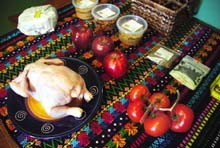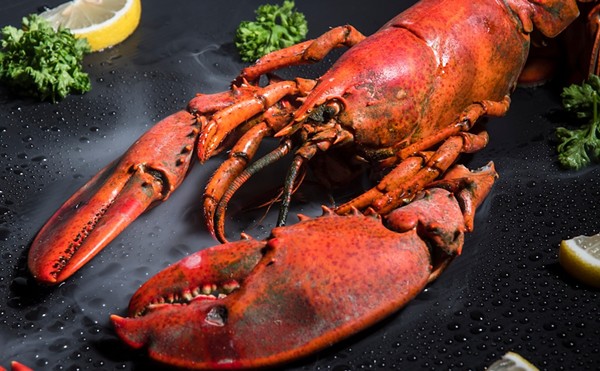Mole is as rich in history as it is in chocolate
| Cristal Rojas takes a break from slicing red apples to share her memories of preparing the dish with her family as she grew up in Xiutepek, a small village outside of Cuernavaca, Mexico. (Photos by Laura McKenzie) |
"The mole is a very special occasion," says Rojas, who immigrated to the United States in 1992. "You're not gonna' make mole every day. It symbolizes all the richness that the town has in offering the guests. It's a ceremony. Not just cooking it. Preparing it, everything. You went to the store, but over there in my hometown, we pick out the tomatoes, the chiles ..."
The smells that fill the kitchen conjure more than just the fertile land of Rojas' youth. The unfolding recipe also recalls a history of Central America that extends back thousands of years, from the first crushed chiles of the Monte Albán culture in the Valley of Oaxaca to the revered chocolate and chile concoctions of the Aztecs in pre-invasion Tenochtitlan.
Rojas, who is of Aztec ancestry, talks about Spanish conquistador Hernán Cortés' first draught of chicahuatl, the Aztec beverage of chocolate and chiles that was the basis for today's complex mole. "When the Spaniards came, Moctezuma invited them to eat," Rojas says as she peels raw almonds. "When Cortés tasted the mole, he said, 'Oh, this is kind of like heaven!'"
With the almonds peeled and the sesame seeds fried, Rojas combines the them in blender and sets it to liquefy. She is aware of the incongruity in applying such high-tech devices to the recipe, but today Rojas is on a tight schedule and cannot prepare the mole in the traditional manner of her forebears. "Let me tell you, this is the modern version," she says as the blender roars, "because my grandma - they rolled everything on the metate."
In Xiutepek, says Rojas, the women work expressly over the metate, a wide stone mortar used to grind every ingredient - the peppercorns, peanuts, tomatoes, apples, onions, and more - into a single sauce. Often, the mole is made to honor a town's patron saint, such as San Francisco of Xiutepek. The mole has to be made in large quantities because the celebration is widespread; communities across Mexico are invited to partake in the food and festivities.
| The ingredients to make mole from scratch are gathered on a table, including tomatoes, red apples, Mexican chocolate, chicken, sesame seeds, peanut butter, almonds, ancho chile paste, garlic, and red onions. |
Chile is an essential ingredient of mole; a particular sauce's color depends on the types of chiles used to make it. Today, Rojas is making brown mole from ancho chiles, a relatively mild variety. There is also green mole, made from poblano chiles, and red mole, which can contain three or four different varieties of red chiles. The dark color of mole negro is often the result of roasting the chiles until they are almost black, as is common in Oaxaca.
Now that the peeled red apples and tomato slices have been blended with onion and cloves of garlic, Rojas is ready to create the final mixture. She pours a layer of olive oil into the pot before adding the ancho chile paste, and then the tomatoes and apples, the sesame seeds and almonds, the peppercorn and cumin, and finally some chunks of natural, unsweetened peanut butter. All this she stirs. Then she adds two bars of Mexican chocolate and a dash of cinnamon and stirs some more.
Rojas is displeased to discover a full clove of garlic swimming in the mix. "That's what happens with the new technology," she says, removing the clove. "The garlics are still here."
To properly grind the clove, Rojas returns to the molcajete. In doing so, she returns to a tradition that has existed for thousands of years in the land of her birth, a region whose culinary legacy will soon grace the kitchen in which she cooks. •
Mole recipe
Although in the United States mole is usually consumed with chicken, Mexicans are accustomed to serving the sauce over turkey. And how does it taste? The first sensation that greets your tongue is one of nutty sweetness, like a mingling of mild chocolate and peanuts. This gives way to a fruity taste coupled with the spice of ancho chile rising in the back of your throat.
Olive oil
Raw almonds
Sesame seeds
Peppercorn
Cumin
2 red apples sliced
4 tomatoes sliced
6 cloves of garlic (3 whole, 3 minced)
1 red onion (half cut in chunks, half chopped)
1/2 c. peanut butter
2 bars Ibarra Mexican Chocolate
Dash of cinnamon
1. Boil raw almonds in water to soften skin, drain, cool, and peel.
2. Fry sesame seeds in a skillet with thin layer oil, stirring continuously, until they are golden brown.
3. Combine almonds, sesame seeds, and a cup of water in a blender. Blend until liquefied and reserve in a bowl.
4. Grind peppercorn and cumin seed in a molcajete, or a mortar and pestle, and reserve.
6. Combine the sliced apples and tomatoes, whole cloves of garlic, 1/2 red onion, and a cup of water in blender, liquefy and reserve.
7. In a pot, heat a thin layer of olive oil. Add the minced garlic and chopped red onion, and sauté until onion is translucent.
8. Reduce the heat to a simmer and add ancho chile paste, sesame seed and almonds, peppercorn and cumin, tomatoes and apples, and X of unsweetened peanut butter. Stir well and add the Ibarra chocolate and a dash of cinnamon. Stir and serve. •
















